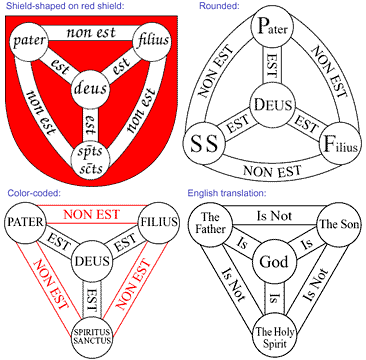How many times have you seen one of these offered as an explanation or illustration of the doctrine of the Trinity?
There’s a really neat article about these here, complete with some links to real medieval examples. Basically, this sort of Shield of Faith (Latin: scutum fidei) diagram seems to have originated in the high middle ages, with the intention of illustrating the doctrine.
In general, I love diagrams & visual aids when it comes to philosophy and theology. But rather than getting you nodding, though, I think this diagram ought to get you scratching your head. In light of some recent musings, we should ask: what does it mean? How, that is, are we to read this chart?
We naturally assume that “is” (est) means the same thing all around. What then, does it mean in the negative parts, e.g. where it says that the Father “is not” the Son. Presumably, one has noticed that some things are true of the Father, that are not true of the Son, and vice versa. By the kind of reasoning we looked at last time, then, the chart is asserting that Father and Son are not identical.
So far, so good. These three claims of the outer ring seem plausible. Now we turn to the positive parts. (“The Son is God.” etc.) Doh! Does anyone see a problem here?
Sorry to bore the philosophers and logicians out there, but permit me spell it out. Identity is by definition a transitive and asymmetric relation. So these two claims
- The Father is God.
- The Son is God.
Imply
- The Father is the Son.
But on the outside of the chart, that very claim is denied. So the chart, on this interpretation, is asserting contradictory clamis: for each of the Persons, that Person is, and isn’t, identical to each of the others.
Now it must be said that this contradictory interpretation is fine with some people! Its supposed to be a mystery, after all, and many mean a “mystery” to be an apparently contradictory doctrine.
The author(s) of the wikipedia article, though, draw a different conclusion:
Of course, if the diagram is interpreted according to ordinary logic, then it contains a number of contradictions (since the set of twelve propositions listed above is mutually contradictory). However, if the three links connecting the three outer nodes of the diagram to the center node are interpreted as representing a non-transitive quasi-equivalence relation (where the statement “A is equivalent to C” does not follow from the two statements “A is equivalent to B” and “B is equivalent to C”), then the diagram is fully logically coherent and non-self-contradictory. So the medieval Shield of the Trinity diagram could be considered to contain some implicit kernel of the idea of alternative logical systems.
The point here is: maybe the “is” in the chart shouldn’t be read as idenity. Whatever relation it is, it must be non-transitive – then, the doctrine embodied in the chart has a hope of being consistent. The million-dollar question, then, is what exactly is this “quasi-equivalence” relation?
In the current literature, I know of basically two such suggestions:
- Michael Rea and Jeff Brower have suggested: “is constituted by“. So, forexample, the Son is constituted by God, but is not constituted by the Father. What is “constitution”? Something analagous to material constitution – the relation between this mass of clay and this clay pot. See this paper for a nice, readable discussion. Professional philosophers (and not many others!) will want to see this, fuller discussion.
- Relative identity. This goes back to Peter Geach, A.P. Martinich, and others, and has recently been defended by Peter van Inwagen. Even though he’s against it, I suggest looking at Rea’s paper here for an introduction to this approach.
Both of these approaches result in a consistent trinitarianism, although other sorts of objections will crop up. Hopefully within the next month or so, I’ll have time to post on these.
Back to the diagram, about the best that can be said about it, is that it illustrates the problem of the (classic, Latin, Athanasian) version of the doctrine. It puzzles rather than informs, which can lead to a more developed, and possibly a believable version of the doctrine. Or it can lead to embracing an apparently contradictory form of the doctrine, which I call mystery-mongering. But that’s another topic.
The post Diagram: Shield of Faith appeared first on Trinities.
